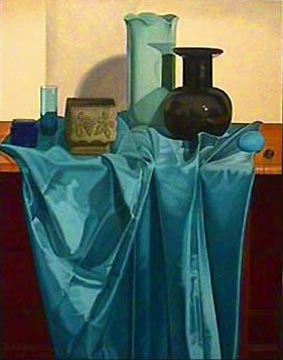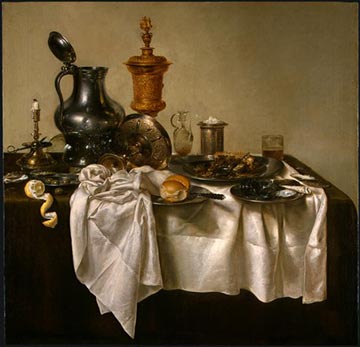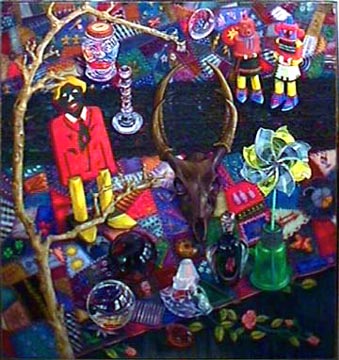
BIDDINGTON'S Index to Content BIDDINGTON'S CONTEMPORARY ART GALLERY
BIDDINGTON'S Auction & Search.


realism
What is it?
Loosely synonymous with "figuration", "representational art" and "illusionistic painting", realism is the term applied to a contemporary style of art depicting recognizable objects or people. While Realism has specific philosophical, art historical & literary roots in earlier centuries, in the 20th century this art term broadened in usage. By the second half of the century, realism (small r) came to be the accepted art term for differentiating representational works from abstract or conceptual ones.
What are the sub-categories within realism?
The broad scope of contemporary realism covers several genres:
still lifes & interiors,
landscapes & cityscapes, and
portraiture & other works with people as subjects. Laura Shechter "Still Life with Blue Cloth"
Contemporary Realist Still Life
How can a painting in a traditional genre--such as still life--be considered contemporary art?
Comparing three contemporary realist still life paintings with a superb 17th century Dutch still life by Willem Claesz Heda helps to illustrate how traditional genres can produce significant new art.

What makes a 21st century still life different from a 17th century still life?
Disregarding the symbols and metaphors rampant in all four of these paintings, they differ greatly on a purely visual level. Like this Dutch painting (left), Laura Shechter's Still Life with Blue Cloth (above) respects a close color harmony. But the contemporary painting uses ultra-crisp edges, hard shadows and odd cropping to represent a strangely airless environment. The result is a work that appears coolly minimal versus the warm opulence of the Heda.
Willem Claesz Heda "Banquet Piece with Mince Pie"
17th Century Dutch Still Life
from National Gallery of Art

Like the Heda still life, Patricia Hansen's "Sunflowers" creates a more or less believable illusionistic space. But the vase, rendered with meticulous precision, contrasts uneasily with the loose and luminous flowers and background. Hansen lets Vermeer encounter Bonnard within the same painting--a freedom quite at odds with the Dutch painter's tight stylistic consistency.
Patricia Hansen "Sunflowers"
Contemporary Still Life Painting

As specific in its selection of items and attention to details of light and reflection as the Dutch painting, Lisa Dinhofer's Americana Crazy places these 3-dimensional objects on a flattened space where they couldn't possibly rest. While the Dutch painting brilliantly employs the received-wisdom of perspective drawing, Dinhofer's space presents an image in the manner of a TV screen or a computer monitor
Lisa Dinhofer "Americana Crazy"
Contemporary Still Life Painting
The Dutch master Heda and the contemporary paints Shechter, Hansen and Dinhofer all use the still life genre to speak clearly of their own time and their own culture. Realism remains alive because, in talented hands, it communicates in a way that nearly everyone can comprehend.
See also the works of these notable contemporary realist still life painters:
William Bailey (American b.1930) Claudio Bravo (Chilean. b.1936) Janet Fish (American b. 1938)
Related article and art project for children:
Still Life Painting by Kate Wattson
More PEDIGREE & PROVENANCE:
P&P: Abstract Expressionism
P&P: Ash Can School
P&P: bronze patina
P&P: citrine
P&P: Colorfield painting
P&P: Greek columns
P&P: Conceptual Art
P&P: coromandel
P&P: depression glass
P&P: enamel
P&P: encaustic
P&P: etching
P&P: faux
P&P: foreshortening
P&P: gouache
P&P: Iconography & Iconology
P&P: New Image painting
P&P: Newcomb pottery
P&P: parfleche
P&P: Pop Art
P&P: porcelain
P&P: realism
P&P: Senufo
P&P: Surrealism
P&P: turquoise
ABOUT THIS FEATURE
In the art & antiques world, experts bandy about arcane words as though they were part of everyone's standard vocabulary. To a fledgling collector, this practice can be maddening. In PEDIGREE & PROVENANCE, BIDDINGTON'S picks a word or phrase and gives it a good, hard going over: defining it, explaining it and showing how to use it.
Glance regularly at PEDIGREE & PROVENANCE, and soon you'll be able to toss those obscure phrases back at the experts with confidence and agility and be fully prepared to bid on items at BIDDINGTON'S upmarket, online art & antiques auctions.
Join the P&P List to Receive Email Updates
CREATIVE PROCESS--Artists' Studio Visits
JAKE BIDDINGTON'S INVESTING--Financial Advice for Art Collectors
BIDDINGTON'S BENTLEY--Travel for the Art & Antiques Connoisseur MY ART--Art for Kids
ASK Mrs. BIDDINGTON--Conservation of Art & Fine Objects
BIDDINGTON'S--Home & Search








